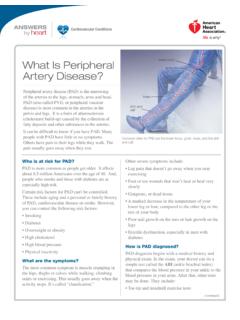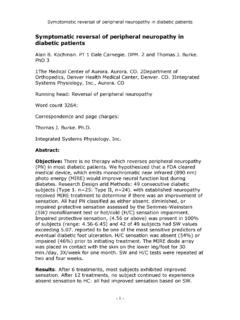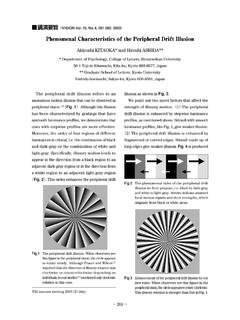Transcription of Hello, and welcome to this presentation of the …
1 Hello, and welcome to this presentation of the STM32 I C interface. It covers the main features of this communication interface, which is widely used to connect devices such as microcontrollers, sensors, and serial interface memories. 1 The I C interface is compliant with the NXP I2C-bus specification and user manual, Revision 3; the SMBusSystem Management Bus Specification, Revision 2; and the PMBus Power System Management Protocol Specification, Revision peripheral provides an easy-to-use interface, with very simple software programming, and full timing flexibility.
2 Additionally, the I C peripheral is functional in low-power stop I C peripheral supports multi-master and slave I C IO pins must be configured in open-drain mode. The logic high level is driven by an external pull-up. The I C alternate functions are available on IO pins supplied by VDD, which can be from to volts, and on IO pins supplied by VDDIO2, which can be from to volts. This allows communication with external chips at voltages different from the STM32L4 main power supply. A typical use case is communication with an application processor in sensor hub IO pins support the 20 mA output drive required for Fast mode peripheral controls all I C bus-specific sequencing, protocol, arbitration and timing and 10-bit addressing modes are supported, and multiple 7-bit addresses can be supported in the same peripheral supports slave clock stretching and clock stretching from slave can be disabled by Setup and Hold times are programmable by software.
3 Analog and digital glitch filters on the data and clock lines can be configured by peripheral can wake up the MCU from Stop mode when an address match is peripheral has an independent clock domain, which allows a communication baud rate independent from the system is the I C block diagram. The registers are accessed through the APB bus, and the peripheral is clocked with the I2C clock, which is independent from the APB clock. The I C clock can be selected between the system clock, APB clock and the high-speed internal 16 MHz RC and digital noise filters are present on the SCL and SDA lines.
4 A 20 mA driving capability is enabled using the control bits in the System configuration addition, an SMBus Alert pin is available in SMBusmode. 5 The STM32L4 embeds noise filters on I C data and clock analog noise filters can filter spikes up to 50 ns and can be enabled or disabled by software. By default, analog noise filters are digital noise filters can be enabled on the SDA and SCL lines instead of the analog noise filters. These filters suppress spikes with a programmable length from 1 to 15 I C clock periods. The digital filters offer an extra filtering capability compared to the 50 ns required by the I C standard.
5 The digital filter value is fixed by software, while the analog filter value may vary with process, temperature and voltage. Take care that the digital filter is disabled by hardware when the Wakeup from Stop feature is enabled. In this case, only the analog filter can be I C setup and hold times can be configured by software through the I C Timing SDADEL and SCLDEL counters are used during transmission, in order to guarantee the minimum Data Hold and Data Setup I C peripheral waits for the programmed Data Hold time after detecting a falling edge on the clock line before sending the data.
6 After the data is sent, the clock line is stretched low during the programmed Data Setup time. The total Data Hold time is greater than the programmed SDADEL counter. This is due to the fact that SDADEL delay is only added once the SCL falling edge is internally detected. The time tSYNC1needed for this internal detection depends on the SCL falling edge, the input delay due to the filters, and the delay due to the internal SCL synchronization with the I C clock . However, the setup time is not impacted by these internal delays. 7 The I C master clock s low- and high-level durations are configured by software in the I C Timings SCL low- and high-level counters start after the detection of the edge of the SCL line.
7 This implementation allows the peripheral to support the master clock synchronization mechanism in a multi-master environment as well as the slave clock stretching feature. Therefore, the total SCL period is greater than the sum of the counters. This is linked to the added delays due to the internal detection of the SCL line edge. These delays, tSYNC1and tSYNC2, depend on the SCL falling or rising edge, the input delay due to the filters, and the delay due to the internal SCL synchronization with the I C I C slave can acknowledge several slave addresses. The slave addresses are programmed into two registers.
8 Own Address Register 1 can be programmed with a 7- or a 10-bit address. Own Address Register 2 can be programmed with a 7-bit address, but the Least Significant Bits of this address can be masked through the OA2 MSK register, in order to acknowledge multiple slave addresses. The two Own Address Registers can be enabled simultaneously. The I C peripheral supports Wakeup from Stop mode on address matches. To do this, the I C peripheral clock must be set to the high-speed internal 16 MHz RC oscillator. Only the analog noise filter is supported when the Wakeup from Stop feature is enabled.
9 All addressing modes are the device is in Stop mode, the high-speed internal oscillator is switched off. When a Start condition is detected, the I C peripheral enables the high-speed internal oscillator, which is used to receive the address on the bus. After an address is received in Stop mode, a wakeup interrupt is generated if the address matches the programmed slave address. If the address does not match, the high-speed internal oscillator is switched off, no interrupt is generated, and the device remains in Stop stretching must be enabled because the I C peripheral stretches the clock line low after the Start condition, until the high-speed internal oscillator is started.
10 After having received an address that matches the programmed slave address, the I C peripheral also stretches the clock line low until the STM32L4 device is woken up. 10 Master mode software management is very simple. Only one write action is needed to handle a master transfer with a payload smaller than 255 bytes. The full protocol is managed by the order to start a transfer in Master mode, I C Control Register 2 must be written with the Start condition request, the slave address, the transfer direction, the number of bytes to be transferred, and the End of Transfer mode.















